Four 80 PLUS Gold Power Supplies Under 450 W, Reviewed
Although high-wattage power supplies get most of the glory, we take our hats off to small, efficient solutions offering more practical output. We take four sub-450 W PSUs and run them through our benchmark suite to see if we can determine a winner.
Corsair RM450
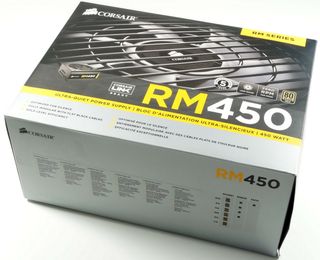
Corsair’s description of its RM power supply family is very matter-of-fact. Gold-certified and fully modular are the two phrases used for marketing, and there's not much else to add except maybe that these PSUs are also optimized for quiet operation. After all, Corsair does enable hybrid fan control, meaning the fan stops when temperatures are low enough to support passive cooling. The outcome, of course, is silent operation in those cases (at least, that's how it's supposed to work in theory).




In any case, Corsair's build quality is good and the materials used are excellent. The RM450's matte black finish and rounded edges look nice, though the chassis isn't as compact as Cooler Master's and Seasonic's competing products. All of the bundled cables are modular and flat. As far as cable length and available leads go, Corsair lands in the middle of the pack. Its single +12 V rail is good for up to 37.5 A, according to the company's specifications. As we’ve seen before, the PSU comes with a five-year warranty.
| AC Input | 100-240 V, 47-63 Hz | |||||||
|---|---|---|---|---|---|---|---|---|
| DC Output | +3.3 V | +5 V | +12 V (#1) | +12 V (#2) | +12 V (#3) | +12 V (#4) | -12 V | +5 Vsb |
| 24 A | 22 A | 37.5 A | N/A | N/A | N/A | 0.8 A | 3.0 A | |
| Individual Output | Row 2 - Cell 1 | Row 2 - Cell 2 | Row 2 - Cell 3 | Row 2 - Cell 4 | Row 2 - Cell 5 | Row 2 - Cell 6 | 9 W | 1 W |
| Rail Utilization | Sys | Sys | CPU & VGA | |||||
| Combined Output | 110 W | 450 W | ||||||
| Total Continuous Output | 450 W | |||||||
| Peak Output | n/a |
A fully modular configuration has the advantage of more flexibility, especially when you need more specialized cables. The flip side of the coin, however, is an efficiency loss. Additional boards, conducting paths, and connectors all have a cumulatively negative impact on this important criteria.
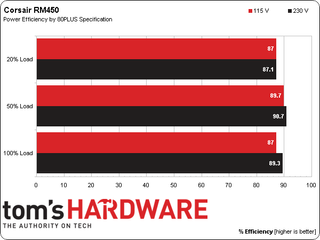
As we might have expected, then, the measurements required for 80 PLUS Gold certification are a close call for the RM450. It manages to hit the three necessary benchmarks with no room to spare whatsoever. Lower loads look worse though, and those are what a normal PC will deal with most of the time. At 50 W, Corsair achieves an efficiency level of 80 percent. This drops all the way to 72 percent at 25 W.
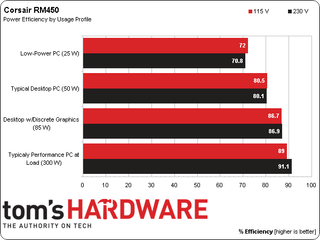
Hold-up time is one of the RM450’s strengths, registering 24 ms. The ripple and noise measurements also speak to this power supply's high quality; they're similar to what we saw from Cooler Master's V450S. We also saw very low power consumption (.04 W) at standby without any load, which is great.
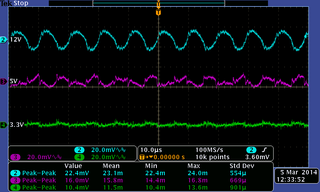
Thus far, Corsair's RM450 looks great. And, due to its dynamic fan control, it should also sail through our acoustic measurements. Then again, we’ve seen power supplies marketed as semi-passive that ended up sounding like hair dryers when their fans spun up.
Fortunately, Corsair's RM450 doesn't disappoint. Under a 200 W load, the fan didn't spin, and after 30 minutes of heat build-up, we were still waiting for it to make noise. We finally triggered the fan at 360 W, and even then it only generated a barely-noticeable 30.4 dB(A).
A Look at the PCB
Corsair has been working with CWT for years, and the RM family is a product of that collaboration. The chassis' build quality is high, similar to everything we find inside.
The input filter is separated into two parts consisting of two X and four Y capacitors, which work in conjunction with a MOV and two choke coils. The primary capacitor is made by Panasonic yet again. We find secondary ones from Nippon Chemi-Con and CapXon, the latter of which seems to be a popular Chinese supplier these days.
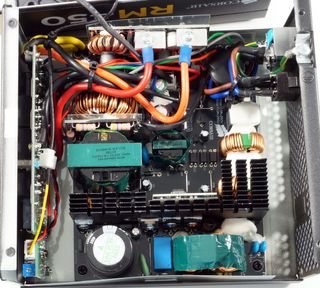
Corsair also uses a DC-to-DC converter topology, but skips the LLC and uses a somewhat dated IC instead. Nevertheless, this configuration is good enough to earn that Gold certification. Solder quality is consistent with what you should expect in this price category.
Stay on the Cutting Edge
Join the experts who read Tom's Hardware for the inside track on enthusiast PC tech news — and have for over 25 years. We'll send breaking news and in-depth reviews of CPUs, GPUs, AI, maker hardware and more straight to your inbox.
-
iam2thecrowe they did ripple tests......they load tested them....... that's about as much as most readers need to know, that it wont blow up at 100% load and wont damage components with excess ripple. better than some reviews i have read "we hooked it up to a pc and it worked, give gold award..."Reply -
Onus Too bad Rosewill did not submit its Capstone for this roundup.Reply
It would have also been nice to see one of Seasonic's TFX units included.
-
xenol Ripple and line noise tests are the indicators of whether or not a power supply is made with solid parts or made with parts that just do the job and will probably last about a year of nominal use before releasing the magic smoke. If there's a lot of ripple, then the motherboard's house keeping circuitry is going to do a lot of work to keep stable voltages (especially when a difference of even 0.1V matters).Reply
Yes, these are supposedly made by top-tier manufacturers, but just because they have a reputation in the past doesn't mean they have a clean slate the entire way through. -
2Be_or_Not2Be I am just happy that we have some reviews of more reasonable P/S. Most people I know aren't running 1000W+.Reply
"In order to keep prices within reason, we settled on an 80 PLUS Gold rating as sufficient to meet our second demand."
I'm also happy with my 80+ Bronze P/S. Frankly, when you're buying smaller output P/S, I really don't know why anyone would need to get a Gold-rated one. -
Adroid Yea I am really confused by the huge price tags here.Reply
I paid like 70$ for a top of the line 660W seasonic platinum PSU after MIR. Needless to say I was patient and waited for a good deal, but I see high quality 650-750W PSUs for 80$ after MIRs regularly. -
hannibal Well good quality 400W PSU can be better choice than good quality 600W version. If it works within its best efficiency area.Reply -
Adroid Reply13725552 said:Well good quality 400W PSU can be better choice than good quality 600W version. If it works within its best efficiency area.
True, PSUs typically operate most effeciently at 80% load. I build gaming rigs though, so 400W is always too small.
I just expected smaller PSUs to be cheaper, that's all.
-
Drejeck There's a big mistake in considering 400W insufficient for gaming. I have a 770 phantom, a 750ti from kfa2 for physx, an i7 2600K at 4,4ghz, various neons, a load of fans, 4 SSDs, 2 black faex 2TB, an asus xonar d2x, and still I can't reach over 420W of power consumption in torture tests, measured with the highest end APC Smart (865W UPS). I have a Corsair 850W Gold, which is a Seasonic rebrand. And I'm ashamed I went so much overkill with my PSU.Reply
This review feels like useless. There's no ripple testing, whatever the second comment user says. Get some review from Guru3D and you'll see.
Based on words I can't compare with other products on other reviews, so this is quite a fail.